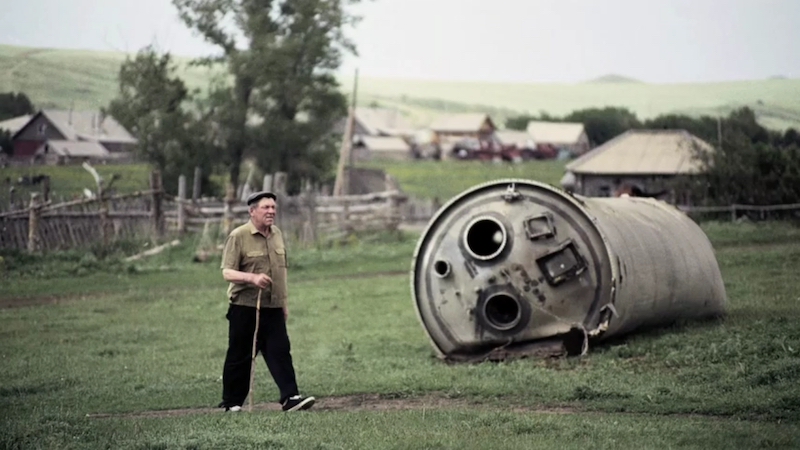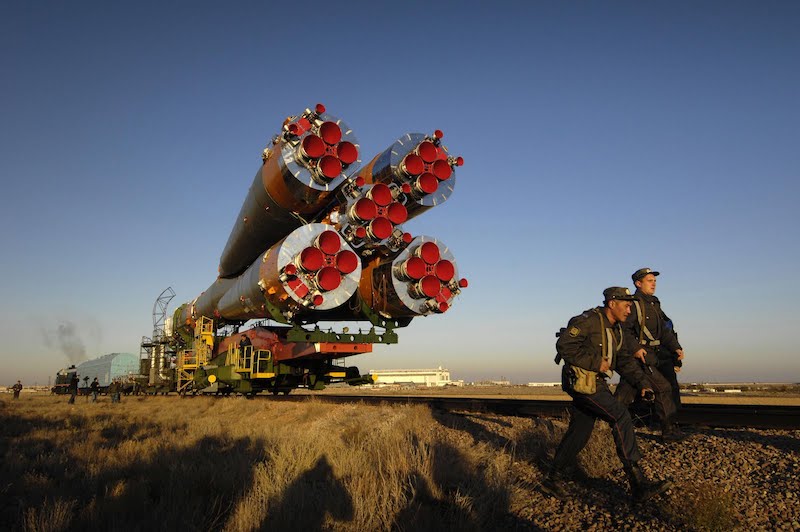This review of Christian Frei’s Space Tourists was originally published on the Doc Channel Blog on November 13, 2011.
One of the reasons I became so interested in nonfiction films is the way cinema provides audiences with a kind of virtual tourism. This can be true for any kind of film, not just documentary, as even sci-fi and fantasy movies take us on trips to other worlds. But if you’re looking for a semblance of actual destinations, docs are the way to go. Unless, of course, the place is space, because I doubt any film can offer a viewer even a quasi experience of what it’s like to travel into the cosmos.
I thought about this while watching Space Tourists, a wonderful documentary by Oscar-nominated filmmaker Christian Frei (War Photographer) that is obviously at least partly about the idea of bringing tourists into space. You’d think if any film could virtually bring us there, too, it would be this one. I just think it’s impossible. While most earthly and subaquatic locations are comprehensible because we can relate them to what land and sea we’ve personally encountered, we have no experiences comparable to space.

And so we may watch this film with greater jealousy and intrigue than most documentaries, including other films about space travel. Frei tracks the training and flight of Anousheh Ansari, a billionaire who paid $20 million to accompany a 2006 Soyuz mission and stay a week aboard the International Space Station. We get a look at what’s basically her vacation video from the trip, seeing the cramped quarters, a glimpse at the space toilet, a few meals, and other activities. Yet aside from the view from her window, it doesn’t seem too exciting. Of course, it must be. The doc doesn’t really work as an ad for space tourism any more than would just considering the concept on our own.
That doesn’t mean the Ansari parts of Space Tourists are uninteresting. They’re incredibly fascinating. I admit, though, to finding some of the other sections more compelling. The film begins as a two-narrative work — hardly common in its storytelling structure. Jumping around in time, Frei first shows us Ansari’s return to Earth, from the viewpoint of a helicopter on its way to retrieve her and two professional astronauts. Then the film goes back and introduces us to Swedish photojournalist Jonas Bendiksen, who has been taking pictures of post-Soviet life around the former republics, including people in Kazakhstan who collect fallen rocket remains to sell as scrap.
“You may be wrapping your sandwich in an old spaceship,” Bendiksen says when explaining how some of that metal ends up in Chinese aluminum foil manufacture. Other pieces end up as crude tools for Kazakh farmers. It’s through Bendiksen, also, that we learn much about the history of the Soviet space program, the logic of launching shuttles from Kazakhstan versus Florida, and the carcinogenic dangers of some of that junk that falls behind in both remote and populated areas. The first expository information we get about Ansari’s trip is also by way of Bendiksen, though not from him. It’s via a news program he’s watching in a café.

Bouncing around some more, we see the excited, emotional Ansari — and her likewise emotional family members — lift off from the Baikonur Cosmodrome before backtracking a day in time to follow a bunch of scrap collectors who drive out into the desert, wake up and watch the rocket launch high above, focused on where the discarded pieces drop, and then load them into their trucks. Later the film introduces us to Romanian engineer Dumitru Popescu, an X Prize competitor whose narrative is least connected to the others. Through his story, however, we learn more about today’s commercial space race and the X Prize Foundation contests (one of which was previously sponsored by Ansari), the next step of which involves private interests in landing on the Moon. A promise, perhaps, that eventually, space tourists like Ansari will be staying at some lunar resort?
Frei’s methods of telling these interconnected stories tied to modern spaceflight are, fittingly, of a revolving nature, and in the end, we’re back to a beginning of sorts with a look at the training ground for the next tourists, in Star City, Russia. There aren’t too many straight interviews in the film, nor is there a lot of direct exposition, although Ansari, Bendiksen, and Popescu contribute some voiceover narration to their sections. It’s a bumpy and winding trip but worth it every moment. And while you aren’t going to know exactly what it’s like to go to outer space in the end, you’ll have taken a virtual tour through as much of the inner and outer workings of what’s involved in modern space travel as you can possibly get from an entertaining, enlightening documentary film.




